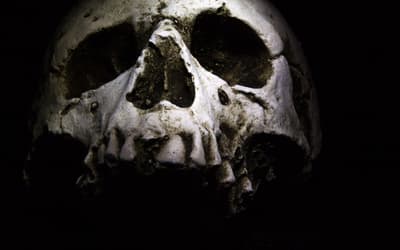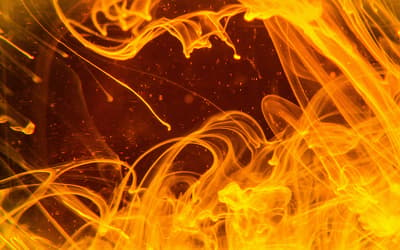Research conducted by Answers in Genesis staff scientists or sponsored by Answers in Genesis is funded solely by supporters’ donations.
Abstract
Many recent creationists believe that the second law of thermodynamics came into being as a result of the Fall or the curse. I argue that this is not supported by Scripture, nor is it a defensible position from a scientific viewpoint. Instituting the second law of thermodynamics at the Fall needlessly causes problems for theology and science. Rather, I propose that the second law of thermodynamics came into the picture during the Creation Week as part of the created order (Nehemiah 9:6; Colossians 1:16).
Keywords: Fall, second law of thermodynamics, entropy.
Introduction to Laws of Thermodynamics
Thermodynamics is concerned with systems that utilize energy, work, and heat, as well as their respective relationships. Physicists define three types of thermodynamic systems: isolated, closed, and open. An isolated system exchanges neither matter nor energy with its surroundings. A truly isolated system does not exist as a subset of the universe, but we can approximate an isolated system very closely. A closed system can exchange energy but not matter with its surroundings. An open system may exchange both matter and energy with its surroundings. There are four laws of thermodynamics, called the zeroth (0th) law, first (1st) law, second (2nd) law (sometimes denoted as the “law of entropy”), and third (3rd) law. Each law is briefly defined below:
Zeroth: If system A is in thermal equilibrium with system B, and system B is in thermal equilibrium with system C, then systems A and C are in thermal equilibrium.
First: Energy can neither be created nor destroyed.
Second: The entropy change of an isolated system can never be negative.1
Third: The entropy of a perfect crystal at absolute zero temperature is equal to zero.
It may seem strange that there is a zeroth law, but that law was formulated after some of the other laws were developed. After some of the other laws were recognized, physicists realized that that the principle of the zeroth law was more basic than the others, and so they inserted it before the others. The first law is the familiar conservation of energy principle. Since the discovery in the early twentieth century that mass and energy are equivalent, the first law has been generalized to allow for the conservation of mass-energy, but only in situations where mass-energy conversion is relevant. Unlike the straightforward statements of the zeroth and first laws of thermodynamics, there are many different statements and formulations of the second and third laws.
All such laws work well within a biblical framework, but the second law seems to stand out among recent creationists. For example, in the universe (seen as an isolated system), where did order come from in the first place, if not from God? On the other hand, atheistic believers in the big bang must posit that the universe came into existence in a very low-entropy state. But its appeal and discussion has led some creationists to propose the idea that the second law was not part of the original created order, but instead was enacted at the fall of mankind. A deeper discussion needs to be given to this issue.
Introduction to Creationist Views of the Second Law
It is a common belief among recent creationists that the second law of thermodynamics came into existence at the time of the curse. That is, one can equate the second law of thermodynamics with the curse. This idea appears to have originated with Henry M. Morris2 where he stated,
Creation (or what biologists imply by “evolution”) actually has been accomplished by means of creative processes, which are now replaced by the deteriorative processes implicit in the second law. The latter are probably a part of the “curse” placed upon the earth as a result of the entrance of sin (Genesis 3:17), the “bondage of decay” to which it has been “subjected” by God for the present age (Romans 8:20–22). (Whitcomb and Morris 1961, pp. 224–225)
Two years later Morris expanded his thoughts. He stated,
The universal validity of the second law of thermodynamics is demonstrated, but no one knows why it is true. It is strictly an empirical law, which has always been found to be true wherever it could be tested, but for which there is no known natural explanation. But the biblical explanation is that it is involved in the curse of God upon this world and its whole system, because of Adam’s sin . . . Therefore, we conclude that the Bible teaches that, originally, there was no disorder, no decay, no aging process, no suffering, and above all, no death, in the world when the creation was completed. All was “very good.” (Morris 1963, p. 37)
He continues:
The second great revealed fact of earth history is that of the fall of man, followed by God’s divine curse on the whole creation. The effects of the curse, manifested particularly in the universal tendency toward decay and disorder and death in the world, have been discussed somewhat already. The second law of thermodynamics has been seen to approximate a scientific statement of the effects of the curse. (Morris 1963, p. 58)
Elsewhere Morris reiterated this position with:
This, then, is the true origin of the strange law of disorder and decay, the universally applicable, all-important Second Law of Thermodynamics. Herein is the secret of all that’s wrong with the world. Man is a sinner and has brought God’s curse on the earth. (Morris 1976, p. 127)
Barnes apparently disagreed with Morris’s opinion, for he wrote,
The Second Law of Thermodynamics began after the existence of a fully wound-up system with Living Maturity. (Barnes 1966, p. 7)
In context, Barnes thought that the second law of thermodynamics was in effect by the end of the Creation Week. However, this appears to have been a minority view for some time among recent creationists. Williams elaborated on what Morris had written:
Dr. H. M. Morris has suggested that the principle entropy increase is a direct result of the curse God placed on the creation as a result of Adam’s sin (Genesis 3:17–19). The creation process would be of course directly opposite to the entropy principle of present scientific processes. In looking over His newly-finished creation the Lord saw that it was very good (Genesis 1:31).
If the perfect holy God created; then the creation would be perfect. Here would be perfection in nature, perfection in the universe, and as for the solid state, perfect crystals. However, today we find very little, if any, perfection in nature, and this change from order to disorder must have occurred by divine edict later than Genesis 1:31. He spoke all nature into being, and then cursed His perfect creation because of man’s sin. Thus the perfectly ordered crystalline materials that God created have degenerated into atomically disordered materials because of the operation of the second law of thermodynamics. The crystalline lattices in solids no longer exhibit order but are filled with defects that interrupt order and cause disorder. (Williams 1966, p. 23)
Three years later Williams returned to this theme, writing,
Morris suggests that the second law of thermodynamics originated when God cursed the creation because of Adam’s sin. At that point death entered the physical universe. Disordering and decay processes began in all natural operations (Romans 8:20, 22). (Williams 1969, p. 146)
And in his conclusion Williams explicitly stated,
The universal trend toward disorder and decay was invoked when God cursed the creation because of Adam’s sin. (Williams 1969, p. 146)
The following year Williams, quoting from Romans 8, wrote,
For the whole creation was made subject to vanity . . .(Romans 8:20).For we know that the whole creation groaneth and travaileth in pain together until now(Romans 8:22). These are essentially scriptural statements of the second law of thermodynamics. Thus it is obvious that the universe is subject to the second law. (Williams 1970, p. 49)
While this last statement doesn’t explicitly endorse equating the Fall with entropy, in the context of his previous writings, it is clear that Williams continued to equate the curse with invocation of the second law of thermodynamics. It appears that while Morris may have conceived the idea that the second law of thermodynamics went into effect at the time of the Fall or the curse, Williams may be more responsible for developing and then disseminating that view among creationists.
During this time, there were some creationists who objected to the equation of the second law of thermodynamics with the curse, though nothing seems to have been committed to print. Some of these objections probably had an effect on Morris, because he later softened or modified his position a bit, for he wrote,
In the primeval creation, however, even though what we might call “decay” processes certainly existed (e.g. digestion, friction, water erosion, wave attenuation, etc.), they must all have balanced precisely with “growth” processes elsewhere either within the individual system or, perhaps more commonly, in an adjacent system, so that the entropy of the world as a whole would stay constant. The entropy of the universe now is increasing, but ideally it should be conserved along with energy. Every process and machine would then have 100% efficiency, with all input energies being converted completely into useful work. Even the heat energy employed in the processes necessitating the force of friction for their operation would be completely productive, with no energy being “lost.” No parts would wear out, no organism would “age” past the point of maximum vigor and productivity, and everyone could easily design and build perpetual motion machines! The above is obviously imaginative, and no doubt imprecise, and incomplete, but it could not be too far off. Everything was designed by an omniscient, omnipotent God to be “very good.” The first law would have stated, as at present, the conservation of mass/energy in all systems, and the second law the conservation of entropy in all systems. But there has been a drastic amendment to the second law! No death of sentient life, either animal or human, was intended in God’s original creation . . . But now everything is proceeding back again to the dust, according to the second law of thermodynamics. “For we know that the whole creation groaneth and travaileth in pain together until now” (Romans 8:22) . . . . The formal announcement of the second law in its post-Fall form is found in Genesis 3:17–20: “Cursed is the ground for thy sake: in sorrow shalt thou eat of it all the days of thy life; thorns also and thistles shall it bring to thee, and thou shalt eat the herb of the field; In the sweat of thy face shalt thou eat bread, till thou return unto the ground; for out of it wast thou taken; for dust thou art, and unto dust shalt thou return.” The curse extended in like form to all of man’s dominion. Man had brought spiritual disorder unto his own dominion; God appropriately imposed a principle of physical disorder on that dominion as befitting its spiritual condition. (Morris 1981, p. 120)
Here Morris appears to begrudgingly allow for the second law of thermodynamics in the original creation, but he speculated that its full affects were ameliorated by some other, unspecified sustaining process that was removed at the Fall. Later Morris (1984, pp. 195–196; 2002, pp. 180–181) repeated this last statement word-for-word, indicating that he did not modify his view further. The things that Morris mentioned here, digestion, friction (required for walking), water erosion, and wave attenuation, are examples of dissipative processes, and hence are manifestations of the second law of thermodynamics. Some of these actions are mentioned or implied in the pre-Fall creation. Digestion would follow from the statements concerning eating food (Genesis 1:29–30; 2:9, 16–17). Walking is implied by the job of tending to the Garden (Genesis 2:15) and by the bringing of animals to Adam (Genesis 2:19). Erosion is implied by the river in the Garden that split into four (Genesis 2:10–14). Critics of Morris’s position apparently had made him aware of these considerations, but rather than abandon his thesis about the second law of the thermodynamics, he chose to modify it with conjecture and some fanciful musings (for example, perpetual motion machines).
This position has taken root among many recent creationists. For instance, Stambaugh has written,
There is neither scientific warrant nor biblical warrant to think that aging, as a decay process, was part of the original creation. So, the second law was certainly functioning before the Fall. But that does not mean there was decay and physical death among the living creatures (man or sea and land animals, and birds—the nephesh chayyah) before the Fall. (Stambaugh 2008, p. 382)
While in his brief discussion Stambaugh does not invoke the loss of some sustaining law at the Fall, he does imply that possibility, but, more importantly, he separates death and decay of living things as simply the result of the second law of thermodynamics. Wise more explicitly agreed with Morris’s later view:
So it appears that what caused the large-scale effects of the curse was not the introduction of a new law (the Second Law of Thermodynamics) but the suspension of some other law. It is interesting that something designed for good (the Second Law) in the original creation could—with as “small” a change as the suspension of another law—cause what is generally perceived as huge negative effects. This is consistent with the idea that the original creation was created by God in such a way that it could exist (at least temporarily) in a fallen state. (Wise 2002, p. 160)
With the admission that manifestations of the second law must have existed prior to the Fall, one ought to question the initial conjecture, that the second law of thermodynamics is to be equated with the Fall. This is particularly important once one separates death from the second law as Stambaugh did. Unfortunately, the most common response is to retain the original conjecture in essence by hypothesizing an additional conjecture about some other law that originally canceled more onerous implications of the second law but ceased to exist at the Fall. In discussion with other creation scientists, it is clear that many of them reject Morris’s position, subscribing instead to a position closer to that taken by Barnes. That is, the second law of thermodynamics was in force at least by the end of the Creation Week. It is a bit odd that few of these people have committed their opinion to print.3 In this paper, I attempt to address this deficiency.
Does “Very Good” Equate with Perfection?
There are several issues that we must tackle. First, many have concluded from
the fact that God is perfect that His creation must also be perfect. This is
more of an assertion rather than a conclusion. Those who argue thus use a few
biblical passages to make their case. One is Deuteronomy 32:4, which states
that “. . . His (God’s) work is perfect . . . .,
” inferring that the work intended
here is the creation. But is it? And does the use here imply perfection as some
people take the meaning of the word? In context, this psalm of Moses in Deuteronomy 32 is about the rebelliousness of the people of Israel. Verse 6 explicitly states
that God made Israel, so obviously this work of God is far from perfect, if
this is the intended meaning.
However, the key passage probably is the “very good” of Genesis 1:31 that some take to mean “perfect,” but is this supported by the Hebrew words here? Prior to verse 31 the Hebrew word for “good” is used in the positive sense six times to describe various parts of creation (light, division of land and sea, plants, astronomical bodies, fish and fowl, land animals). Interestingly, this description appears twice in the Day Three account, but not at all in the Day Two account.4
Furthermore, in the creation account this word is used once in the negative sense, in Genesis 2:18 when God stated that it wasn’t good that man was alone. What is the good that is referred to in these usages? There are at least two possible meanings of the Hebrew word for “good” here, and they reflect two of our meanings of the word “good” in English, so this is a good translation. One possible meaning refers to morality. Since sin and the taint and consequences of sin had not yet entered the world, this would be appropriate. However, the word also can convey the meaning of completeness or purpose. Certainly, that is the intended meaning in Genesis 2:18 in that Adam was incomplete without Eve.
Each of the six uses of just the word “good” in the first chapter of Genesis probably refers to the completeness of what God had made, because He had accomplished what He had intended for each of His creative acts. Since they were complete, they also fulfilled their intended purposes. At the end of the Creation Week, it was appropriate that God then pronounced all “very good,” for He had finished what He had set out to do. That is, each of God’s creative acts were good when finished as far as they went, but it wasn’t until all were finished was it best to sum up with the pronouncement of “very good.” See the more complete companion paper by Anderson (2013) on this topic.
Still, can we equate this “very good” with perfection? Since the taint of sin had not yet entered the world, certainly. But then there is a problem with equivocation, for we often use the word “perfect” in several distinct ways. To be morally perfect means to be without sin. We also describe something as perfect if it is without blemish or fault. But a blemish or fault doesn’t have to have a moral component. For instance, a perfect attendance record means that one has not missed a meeting, but there is nothing immoral about missing a meeting for illness or bereavement. A perfect test paper has no wrong answers, but there is nothing immoral about not knowing the correct answer to a question. A perfect solution to a problem solves the problem without introducing new problems. In the physical realm, we frequently speak of faults or defects, even though there is no moral component involved. In offering a Passover sacrifice, the lamb had to be spotless (perfect), but that did not preclude any genetic defects being present. Indeed, we understand today that all lambs carry a few genetic mutations, but that those mutations do not manifest themselves in a “perfect” lamb. Most solids consist of a crystalline array of particles, the particles being atoms, ions, or molecules. A crystal normally has an alternating pattern of particles, so that once one knows the pattern, one can predict the location and identity of a particular particle anywhere in the crystal. But all crystals have deviations from the pattern. These deviations are defects in the sense that they fall short of the simple ideal of the pattern. There is absolutely no sin or immorality involved, yet Williams (1966) argued that such a situation violated the perfection of the initial creation and hence concluded that all crystals originally were perfect (had no defects). Again, this is equivocation, for the word perfect is used in two different senses.
To illustrate the absurdity of this position, consider diamond, which is a crystal. Diamond has a high index of refraction, so light is bent and dispersed within a diamond. This is what gives a diamond its rich and vibrant color. Many facets greatly increase this illusion, and hence many facets improve the appearance of a diamond. On the other hand, the presence of defects in the crystal can interfere with passage of light in the diamond and hence detract from the appearance. Thus, the number of defects in a diamond largely determines the value of the stone—the fewer defects that diamond has for a given size, the more attractive, and hence more valuable, the diamond will be.
To improve the appearance, diamond cutters shape stones to maximize the number of facets. Diamond is essentially the hardest substance, and so we cannot easily cut diamonds with saws. Rather, diamond cutters frequently take advantage of naturally occurring weaknesses between planes in the crystal to cleave, or break, diamonds to produce these facets. However, these weaknesses between planes are deviations from the ideal crystal and hence amount to defects in the crystal. That is, a “perfect” diamond (one with no flaws) could not be cut. We could not improve upon its appearance, so unless this “perfect” diamond already has a large number of facets, it would not be as pretty as possible. This introduces a catch-22: this “perfect” diamond would not be as pretty as it could be, thus it isn’t perfect. Even here, I have equivocated with the word “perfect,” for I’ve used the word to refer to a diamond with no defects and to refer to a diamond with exquisite appearance. Of course, one could argue that if diamonds existed in the original creation that all of them had the maximum number of facets and no defects. This is not how we find diamonds today, so this amounts to a new assertion, and results in piling conjecture upon conjecture to salvage a teaching that is not required by biblical texts.
Entropy
The second law of thermodynamics probably is one of the slipperiest things in science. One reason for this is that the second law has many manifestations and hence many different statements. I will not even attempt to describe the second law in great detail. In its most basic form, the second law describes the direction in which heat flows spontaneously, from hotter to cooler regions. To express this, we define a quantity called entropy. Entropy is the ratio of heat flow to temperature, so entropy has the units of heat flow divided by temperature. In physics, the standard unit of heat is the Joule, while the standard unit of temperature is Kelvin, so the standard unit of entropy is Joule/Kelvin, abbreviated J/K. Consider two objects, one hotter and one cooler. If we place the two objects next to one another so that heat can flow between them (we say that they are in thermal contact), we will find that heat will flow from the hotter to the cooler object until their temperatures equalize (when we say that they’ve reached thermal equilibrium). To compute the entropy change of either object, we merely divide the heat flow of either object by its temperature. The temperature changes continuously during the heat flow, so this is not a simple calculation, but we can carefully consider the situation to reach some broad conclusions. Since the hotter object loses heat, its heat flow will be negative. But the heat flow of the cooler object will be positive, because it gains heat. If the only heat flow involved is between the two objects, then the total heat flow will be zero, because the gain of one is at the expense of the other. If this criterion is met, then we say that the system (the two objects together) is thermally isolated. This insures that the heat flows of the two objects are equal and opposite.
But what of the entropy change of either object? It is important that we express the temperature on an absolute scale, such as K, because then there are no negative temperatures. Dividing heat flow by positive temperature insures that entropy change always has the same sign as the heat flow. Therefore, the entropy changes of the two objects will be opposite in sign. However, they won’t be equal in magnitude. This is because we will divide opposite but equal heat flows by different temperatures. The temperature of the hotter object always will be greater than or equal to the cooler object’s temperature (but the heat flow becomes zero when they reach the same temperature). So in computing the entropy change of the hotter object, we will always divide its heat flow by a larger number than we do in computing the entropy change of the cooler object. Therefore, the absolute value of the entropy change of the hotter object always is less than the entropy change of the cooler object. When we add a positive number to a negative number that has less absolute value than the positive number, we always get a positive number. So, we find that in this experiment of heat exchange that the total change in entropy is positive. I have not given specific values in this example, so it suffices for the general case. Therefore, we can state the second law of thermodynamics with regard to heat flow between objects in an isolated system as “The entropy must always increase.” Indeed, entropy is defined in such a way as to guarantee this general result.
Note that this works only in an isolated system. If we were to consider the entropy change of the hotter object alone, its entropy change would be negative. Obviously, the second law of thermodynamics cannot apply in this case, because we have not properly formulated the system, for the system consisting of only the hotter object is not thermally isolated. However, this does not mean that the object cannot cool, for it will. To resolve this, we must expand the system to include whatever other objects the object is losing heat to, in this case the cooler object. There is a complication in that the system consisting of the two objects technically is not thermally isolated, for no matter how hard we try to insulate the two from the rest of the universe, there will be some leakage of heat into or out of the system. If we do a particularly bad job of insulating the system, it is possible that the entropy change of the system could be negative. This isn’t a violation of the second law of thermodynamics, but rather indicative that the system is losing significant heat to its surroundings. We could expand the size of the system to include the immediate surroundings, but no matter how well we do this, there will be some leakage of heat into or out of the system. However, all is not lost, because with care our systems often can approximate the idealized isolated system. In physics we often approximate idealized systems with real ones. An example would be a well-lubricated apparatus approximating a frictionless situation.
Even then, as previously mentioned in a footnote, Sommerfeld formulated the second law in differential form. Sommerfeld commented,
The statement in integral form, namely that the entropy in an isolated system cannot decrease, can be replaced by its corollary in the differential form which asserts that the quantity of entropy generated locally cannot be negative irrespective of whether the system is isolated or not, and irrespective of whether the process under consideration is irreversible or not. (Sommerfeld 1956, p. 155)
So even in cases in which the system is not strictly isolated, the second law still applies.
What does this have to do with creation? Entropy appears a bit contrived. At least it’s not as obvious or tangible as other quantities that we use in physics, such as time, mass, length, and electrical charge. This peculiar characteristic prompted physicists to cast about for some idea of what entropy is. One consequence of the second law of thermodynamics is that if there is a temperature difference within a system, we can exploit that difference to drive an engine to obtain useful work. This is the principle behind a heat engine, such as a steam or internal combustion engine. High temperature gas in one portion of the system can push against a piston or turbine en route to a region of lower temperature, thus producing work. This cannot happen if no temperature differential exists. Furthermore, the flow of heat from hotter to cooler is the direction in which the system will naturally change, but it is possible to derive useable work only if we employ some sort of device or machinery to tap the energy.
Other statements of the second law of thermodynamics describe the manner and limits of the possibility of obtaining useful work this way. Because the natural tendency is for heat to flow so that temperature differences are eliminated (this is the second law), we can say that the original configuration of a temperature difference within the system is more ordered (in which we can extract work) than the final state of thermal equilibrium (in which we can’t extract work). If this is correct, then entropy appears to be some sort of measure of how much order is present in the system. More specifically, since the second law of thermodynamics demands that entropy within an isolated system must increase, and at the same time the system moves toward less order, entropy would appear to be a measure of how much disorder is in the system. This, too, is a bit odd, because we are measuring something by how much it is absent.
The identification of entropy with the amount of disorder present in a system is consistent with other approaches to the second law of thermodynamics, such as that coming from the microscopic behavior of particles in a gas (statistical mechanics). Difficulty begins to arise when people take the disorder interpretation (considering it a mandate of decay) of entropy with little regard for the origins of the definition of entropy. Many times creationists use the words “order” and “complexity” interchangeably, but they are not the same thing. A crystal is a very ordered system, for the particles involved follow a very regular pattern. This pattern is very simple, so a crystal is not a complex system. On the other hand, a hurricane would appear to be the epitome of disorder, but it is a very complex system, as evidenced by our difficulty in modeling hurricanes. Living organisms appear to be both complex and ordered. The argument put forth by some creationists is that the second law would seem to require that order and complexity diminish with time. Related to order and complexity is information, something that living organisms contain in the form of DNA. Just as systems do not spontaneously generate order and complexity, it would seem that systems cannot spontaneously generate information either. That is, the genetic code and the machinery of living organisms could not have arisen naturally, but rather their existence requires a Creator (Gitt 2006).
While this approach has merit, some difficulties subtly creep in as well. One problem is difficulty in quantifying the entropy involved in order, complexity, or information. Entropy is easily quantified in the case of heat flow and in the order present in statistical mechanics in terms of the number of microstates. The lack of quantitative analysis of entropy when discussing order, complexity, or information leaves us with subjective means of assessment. With no objective measure, entropy, like beauty, may be in the eye of the beholder. An example of this occurred in a debate between a recent creationist and a long-age astronomer a number of years ago. Arguing from the assumption of the big bang, where the universe began with mostly hydrogen and a little helium, leaving the heavier elements to be synthesized in stars, the astronomer opined that hydrogen is less entropic than the other elements. The recent creationist scoffed at that, asking what one could make out of hydrogen. He reasoned that elements heavier than hydrogen, such as carbon, were required to build complex molecules, and hence the heavier elements must be less entropic. The recent creationist was relying upon a subjective analysis of what was possible chemically. However, hydrogen fusion is the most energetic nuclear reaction, and the hydrogen nucleus is not tightly bound compared to other nuclei. The fact that we can obtain energy from hydrogen nuclei indicates that they are far from the most entropic state. Nuclear reactions amount to a heat engine. Carbon is more tightly bound than hydrogen, and carbon can be the product of nuclear reactions that begin with hydrogen. For the record, the iron nucleus is the most entropic state. That is, if nuclear reactions were taken to their ultimate conclusion to liberate the maximum energy, all the nuclei in the universe would be iron. Therefore, the subjective judgment of entropy in this case was wrong. Such subjective assessments of the entropy ought never to trump the quantitative measurements of entropy. I will return to qualitative assessments later.
Some recent creationists argue that focusing on computational entropy is too restrictive. They insist that the second law of thermodynamics, with which physicists concern themselves, is a particular manifestation of a much broader principle. That principle is one of decay. This may be true, but until this principle is explicitly defined, different people will reach different conclusions. This indicates that this is not an exact science. It strikes me as improper that many creationists would dismiss a well-formulated, quantitative expression of the second law of thermodynamics in favor of some as of yet unframed, nebulous description of some hypothetical broader principle.
Returning to living organisms, evolutionists point out that living things are open systems, and hence the second law of thermodynamics does not apply. It is true that living organisms are open systems, particularly when we view organisms as heat engines. Living and growing things take in energy, either in the form of solar radiation used in photosynthesis or in the form of food. Organisms also take in and give off matter as well. This is the definition of an open system. However, as previously mentioned, there is a form of the second law in open systems, and it places restrictions on the maximum efficiency that a living organism may have.
Of course, in terms of entropy, one may expand the system to include the environment that the organism is exchanging matter and energy with to see that entropy actually does increase, albeit at the expense of the environment surrounding the organism. If there is a general tendency to decay, then organisms at some points appear to violate this. Multicellular organisms begin as single cells that rapidly increase in number and construct the various tissues, organs, and systems that make them up. This would amount to an increase in complexity. For many organisms, such as birds and mammals, this growth and development ceases at maturity. Eventually organisms become old and die, and many recent creationists attribute this to the supposed second law of thermodynamics generalized with regards to universal decay. But is it? Organisms have repair mechanisms that fix damage as it occurs. The repair mechanism can fix damage due to aging, thus counteracting the aging process. This doesn’t violate the second law of thermodynamics, because living organisms clearly are open systems, and so they can import the energy and material to make this happen.
However, in today’s world the repair mechanism eventually begins to fail, and this leads to aging. The repair mechanism ought to be able to repair itself, so there is no a priori reason why aging cannot be counteracted. Indeed, cells can repair some genetic errors made in copying. But it appears that all repair mechanisms are programmed to fail at some point. Evolutionists posit that this is required to make room for descendants so that evolution can function. Creationists believe that this is required by the necessity of death as the penalty of sin. The imposition of this reality did not require the invocation of the second law of thermodynamics, nor will the reversal of this reality require the removal of the second law. From a physical standpoint, all that is required for death is the designed failure of the repair mechanism, and all that is required for eternal life is the restoration of the original repair mechanism. That is, immortality can exist in a world where the second law operates, as long as the organism takes in energy and matter and can repair itself.
There are several implied features of the finished but pre-Fall world that require the second law of thermodynamics to operate. We know from Genesis 1:29–30 that before the Fall Adam and Eve ate, as did the animals. Digestion follows consumption of food, and digestion is an excellent example of the second law of thermodynamics in what amounts to a heat engine. Digestion removes nutrients and energy from the consumed food, but this process isn’t 100% efficient. If it were, human and animal waste would not be suitable fertilizer, nor would dry manure burn. If the process of digestion were 100% efficient, there would be a question of whether elimination of waste would be necessary. Walking is implied for both Adam and animals. However, walking requires friction, and friction dissipates energy, usually in the form of heat. This is energy that cannot be recovered and hence is unavailable for work. Hence, energy is no longer useful for work, in accordance with the second law of thermodynamics. Even seeing the sun and stars depends upon the second law of thermodynamics, because the surfaces of the sun and stars are hot, and the second law insures that heat flows via radiation from the hotter locations to cooler locations.
How do proponents of the invocation of the second law of thermodynamics at the Fall respond to these criticisms? Generally they respond as Morris did in his previously mentioned modification. They claim that some form of the second law of thermodynamics indeed existed at the beginning, but that it was not fully manifested until the Fall. At the time of the Fall the second law was amended to the way it is today. Of course, there is no biblical or physical evidence for this, but it merely is piling additional conjecture upon what was already a questionable conjecture. No clarity is offered, asserting instead how wonderful the pre-Fall world was, so wonderful that we cannot even contemplate how the second law might have operated then.
Proponents of the invocation of the second law of thermodynamics at the Fall frequently combine the effects of the Fall and the curse. It is clear from Genesis 2:16–17 and Genesis 3:7 that death as the penalty of sin was immediate. Spiritual death was immediate, but, though they didn’t physically die that instant, Adam and Eve were placed on the inexorable path to physical death at that time. The curse(s) came later, because at the very least it took time for Adam and Eve to envision and construct the fig leaf clothing. The serpent was cursed as were other animals (Genesis 3:14), and the ground was cursed (Genesis 3:17–19). Many treatments of the second law of thermodynamics in this context merge the effects of death and the cursing of the ground, but this is sloppy hermeneutics, for they were not necessarily imposed at the same time.
The appearance of thorns and thistles does not require the sudden change in thermodynamics. Rather, thorns could have appeared as a result of a change in the genetic structure of certain plants. Nor does the introduction of death require a change in physics, but rather a change in the biology of repair mechanisms that still operate today, but not as well as they could. Either of these effects of sin is explained easily by means other than radical changes in the physics that appear to govern the world. The insistence of the beginning of the second law of thermodynamics at the Fall is merely an assertion. Upholding the universe in perfect harmony is not the same as having the universe without the second law. It is true that we have essentially been given a “taste” of what life is like without God as of the Fall but this has little, if anything, to do with the second law.
The subjective nature of what is “ordered” or “perfect” results in another problem: the supporters of the invocation of the second law of thermodynamics at the Fall become the arbiters of what is perfect or ordered. There are numerous examples of conclusions that some recent creationists have reached based upon this questionable notion. Craters couldn’t exist in this perfect world, so all craters must be post-Fall. Supernovae fall short of this ideal of perfection, so they must be post-Fall too. The original perfect earth had to have a perfect tilt, which is zero degrees, so the original earth had no axial tilt. The current calendar arrangement of days, months, and years is less than perfect, so originally there were 30 days per month, and the year had 360 days (I’ve previously critiqued this idea—see Faulkner [2012]). But why stop there? Irrational numbers strike me as less than perfect, but I seriously doubt that the value of π changed at the Fall.
In a forthcoming paper I plan to discuss craters in the context of recent creation. Those who subscribe to the notion of the perfection of the original creation that I’m critiquing here will reject any possibility of craters existing before the Fall. The surfaces of the moon, the planets, and the satellites of the planets had to have some appearance prior to the Fall. What was that likely appearance? Were there hills and valleys? If so, what caused those? Uplift and erosion? Don’t those processes imply imperfection? If this belief about perfection is carried to its logical conclusion, one must surmise that astronomical bodies originally had perfectly spherical surfaces. But this hardly is a Christian idea. The ancient pagan Greeks thought that there were two realms—the terrestrial and the celestial. The celestial realm was perfect, but the terrestrial realm was marred by imperfection (but this was not tied to sin). This led to the division between the sacred (heavenly) and the secular (worldly) that permeated thinking during the dominance of the Roman Catholic Church.5
It also stifled science. The ancient Greeks reasoned that since the heavenly realm was perfect that the heavenly bodies must follow perfect motion. They further reasoned that the circle was the perfect shape and that uniform motion was the perfect motion. Therefore, the ancient Greeks concluded that heavenly bodies must follow uniform circular motion. This led to the Ptolemaic model. The Ptolemaic model was the most successful theory in history—it was widely believed for 15 centuries. It’s no coincidence that it was rejected four centuries ago at the same time that science as we know it began to develop. This path through perceived perfection seemed reasonable to many people at the time, but now we recognize the folly of this position and how it held back scientific advancement. I fear that a similar thing is happening with many recent creationists today as they pursue a blind alley of their view of perfection that they think is required by the creation and Fall accounts. I urge rejection of this approach.
Conclusion
It is a common notion among recent creationists that the second law of thermodynamics came into being at the time of the Fall. This is not something that is clearly taught in Scripture, but rather it stems from a particular view of the Fall and the nature of the curse. This idea goes beyond what the Bible actually tells us, and so ought to be viewed with some suspicion. There were numerous processes present in the original creation that today we easily recognize involved the second law of thermodynamics. To account for this fact, supporters of this position suggest that some form of the second law of thermodynamics existed from creation but that it was amended at the time of the Fall to its full implementation that we have today. Alternately, some other process allegedly in force was withdrawn at the time of the Fall. Unfortunately, these ideas have not been developed to explain how it might have worked. Absent this development, this idea is just further conjecture to salvage what was conjecture to begin with. It would be most helpful if supporters of this approach would develop this further.
Many years ago, Barnes proposed that the second law of thermodynamics existed during the Creation Week or at the very least came into existence late that week. However, this idea received scant attention and almost no published support. This idea has merit, and it ought to be further developed. I hope that my effort here will spur further discussion of this important topic.
References
Anderson, L. 2013. Thoughts on the goodness of creation: In what sense was the creation “perfect?” Answers Research Journal 6:391–398.
Barnes, T. G. Jr. 1966. A scientific alternative to evolution. Creation Research Society Quarterly 2, no. 4:5–8.
Faulkner, D. R. 2012. Was the year once 360 days long? Creation Research Society Quarterly 49, no. 2:100–108.
Gitt, V. 2006. In the beginning was information. Green Forest, Arkansas: New Leaf.
Morris, H. M. 1963. The twilight of evolution. Grand Rapids, Michigan: Baker.
Morris, H. M. 1976. The Genesis record: A scientific and devotional commentary on the book of beginnings. Grand Rapids, Michigan: Baker.
Morris, H. M. 1981. Thermodynamics and biblical theology. In Thermodynamics and the development of order, ed. E. L. Williams. Kansas City, Missouri: Creation Research Society.
Morris, H. M. 1984. The biblical basis for modern science. Grand Rapids, Michigan: Baker.
Morris, H. M. 2002. The biblical basis for modern science: The revised and updated classic! Grand Rapids, Michigan: Baker.
Sommerfeld, A. 1956. Thermodynamics and statistical mechanics. Lectures on theoretical physics. Vol. 5. New York, New York: Academic Press.
Stambaugh, J. 2008. Whence cometh death? A biblical theology of physical death and natural evil. In Coming to grips with Genesis: Biblical authority and the age of the earth, ed. T. Mortenson and T. H. Ury, pp. 373–397. Green Forest, Arkansas: Master Books.
Williams, E. L. 1966. Entropy and the solid state. Creation Research Society Quarterly 3, no. 3:18–24.
Williams, E. L. 1969. A simplified explanation of the first and second laws of thermodynamics: Their relationship to Scripture and the theory of evolution. Creation Research Society Quarterly 5, no. 4:138–147.
Williams, E. L. 1970. Is the universe a thermodynamic system? Creation Research Society Quarterly 7, no. 1:46–50.
Wise, K. P. 2002. Faith, form, and time: What the Bible teaches and science confirms about creation and the age of the universe. Nashville, Tennessee: B & H Publishing Group.
Whitcomb, J. C. and H. M. Morris. 1961. The Genesis Flood. Grand Rapids, Michigan: Baker.














